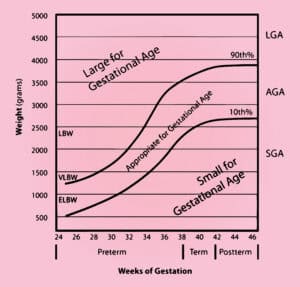
When planning and undergoing pregnancy, nobody is more excited than the expectant parents, for the baby’s arrival. Counting days is normal in this state of euphoria. But it’s not just you but also your doctor who has to count the days to understand how the little blip in your womb is growing and developing before it arrives healthy and happy.
This concept of counting days in medical terms is called a gestation period. It is a vital part of your pregnancy, not just for you but also for your OB-GYN. So let us understand what is the significance of a gestational age as we read ahead.
Table of Contents
The time period between conception and childbirth is called the Gestation period. This is the period during which the baby develops inside its mother’s womb. Therefore, gestational age is commonly used to describe how far along the pregnancy is at that given point in time. Usually, it is measured in weeks.
Pregnancy has to be carefully monitored to help keep it smooth and free from complications. This is why the gestational age becomes a vital piece of information needed by doctors. It helps them identify the right time to perform various tests and assessments of the baby and the mother’s health at different points throughout the pregnancy.
The thumb rule is: we start from the first day of the expectant mother’s last menstrual cycle to the date on which we are currently prior to the delivery. The gestational age ends with childbirth, however, it can be determined before or after birth.
A normal pregnancy tenure lasts between 38 to 42 weeks. This is why gestational age is also measured in weeks. A child born before the completion of 37 weeks, is considered premature. And if they are born after the 42nd week, they are considered postmature.
Gestational age before birth can be ascertained through ultrasound imaging, where your healthcare partner will measure the baby’s size, especially that of its head, abdomen, and thigh bone. This gives a clear indication of the baby’s fetal development in the womb.
Gestational age can be measured after birth by physically examining the newborn’s weight, length, head circumference, vitals, reflexes, posture, muscle, skin and hair. When the baby’s gestational age equals its calendar age, then the baby is said to be Appropriate for Gestational Age (AGA). These children have lower mortality rates than those who are born too small (SGA) or large (LGA) for their gestational age.

Source: Gestational age chart, how to calculate gestational age & corrected age (healthjade.net)
Over the years ultrasound has emerged as an accurate method of assessing gestational age, especially through transvaginal and transabdominal probe assessments. Transvaginal USG is preferred during the first trimester of pregnancy. Here are some of the sonographic methods of evaluating gestational age:
USG within the first 13 weeks and 6 days gives the best estimate of gestational age. Here, the transvaginal approach often provides a more clear and more accurate view. The gestational sac and yolk sac are the first visible markers, but sometimes they don’t really correlate with gestational age.
If it is not determined within the first trimester, then the crown-to-rump measurement of the foetus is considered a good way to assess the development during the second trimester as the baby is bigger and more palpable to USG imaging.
This is an old but proven method where postnatal gestational age is determined on a point-scoring pattern based on physical and neurologic assessments of tone, patterns, reflexes, movements, abnormalities, and behaviours. Higher scores translate to greater maturity.
This is an improved postnatal scoring system used for premature babies. It assesses 6 physical maturity components: skin, lanugo, plantar creases, breast, ear/eye, and genitals. And six neuromuscular components: posture, wrist, arm recoil, heel to ear, etc.
However, there are other non-sonographic methods also used to measure gestational age.
Identifying the gestational age accurately is the task of fertility experts and gynaecologists. The team of experts at the CK Birla Hospital, Mother and Child Department will not only help you plan your pregnancy smoothly but will also regularly assess your and your baby’s health and development to promptly identify any complications that can be completely averted.
Miscarriage is most likely to occur during the first trimester of the pregnancy itself. The commonly noted gestational age is around 12 weeks. However, it must be noted that the first trimester is the time when most miscarriages take place without the person knowing they are pregnant. Due to a hostile environment in the womb, the fertilised egg does not develop and the body miscarries the pregnancy.
When a pregnancy terminates before 24 weeks, it is termed a miscarriage. Miscarriages are common in the first trimester due to developmental problems with the baby in the womb. It can happen early on in the pregnancy, even before 14 weeks.
A full-term pregnancy lasts for 9 months. To assess the bodily changes and foetal development, these nine months have been divided into 3 equal parts of three months each. This is why they are called trimesters. However gestational age is measured in weeks, so it is not the same as a trimester. But if the pregnancy has completed 13 weeks of gestation, it has completed a trimester. Trimesters apply to the pregnant mother, gestational age applies to the growing baby.
Gestational age is measured from the first day of your LMP or last menstrual period. Fetal age is calculated from the actual date of conception, that is when the woman is ovulating. This implies that the fetal age is approximately two weeks behind the gestational age, which is the actual age of the fetus.